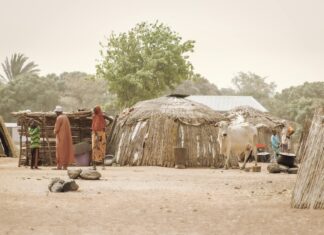When the first patient with coronavirus in Nigeria was tested positive on February 27, 2020, observers cautioned that Nigeria might soon cross 100 mark. That moment came on Sunday.
Indeed, when the zoonotic coronavirus pandemic was first reported on December 19, 2019, by the World Health Organisation, only few people knew it would eventually spread to Nigeria. The virus has now spread to nearly every world, infecting nearly 446,000 people we know about and many more people we do not know about. It has collapsed economies, disrupted structures of health care, filled hospitals, and drained public spaces. The pandemic has succeeded in separating people from their workplaces and theirs friends.
In Nigeria, this is devastating our society on a scale never seen by most living people. Like the 1967-1970 Nigerian Civil War, this virus is engraving itself on the consciousness of the country.
Moments ago, Nigeria Centre for Disease Control announced that 111 people are infected with coronavirus, including one death. While this figure pale in significance when compared with other countries that have been assailed by this pandemic, the challenge is that with the current population of 204,772,072, according to the United Nations data, Nigeria is the world’s most populous black nation, meaning it provides a vast pool of residents who can potentially get infected with the disease.
A series of slipups and missed chances eclipsed the reaction from the government. Among them: a refusal to take the plague seriously just as it ravaged China and Europe, a ruthlessly defective attempt to provide wide-ranging tests of the virus, and a dire shortage of ventilators that can keep the critically ill alive.
The example of other epicentric countries who once crossed 100 cases and what followed is enough to make the country shudder and tremble.
Take Italy for instance, on January 29, when the European nation detected and isolated its first two cases, Italian prime minister was confident he had put together the safest protection system in Europe by his declaration of a state of emergency and the blockage of flights from China.
But by 22nd February, Italy crossed the 100 marks but by March 11, the European nation recorded the second-highest number of infections outside China. 18 days after it crossed the 100 marks, authorities had confirmed 12,462 cases and 827 deaths.
Another example is New York, the commercial capital of the United States of America, where the first known case was confirmed on 20th January, 2020. It took nearly two months for the country to record its 88th cases on March 12th. However, it all went downhill from there. Within eight days, the state recorded its 5,683 cases while the number of recorded cases as at March 28th stands at 30,765.
But how did this happen? Why did Italy, the United States, Spain and other countries have so many cases and deaths so quickly? And most of all, could this have been prevented?
While it is too early to be certain, there is rising consensus among researchers that fatal coronavirus cases have not, in fact, quickly hit those countries. Some suspect the virus has been circulating unnoticed in the country since at least mid-January, flourishing as many of the patients have no symptoms at all, or mild symptoms such as cough and low temperatures. This claim is consistent with recent studies showing that people who are yet to display any symptoms can spread the virus.
With the pandemic now rapidly spreading to other countries where sharp rises are being recorded. The experience of other countries that have passed 100 marks should serve as a case study and a warning for Nigerian government at every level as well as the citizens about how quickly and decisively we need to act.
With the current figure, Nigeria ranked 116, out of the 198 countries where the coronavirus persists. But this does not call for jubilation as the same statistics from the Nigeria Centre for Disease Control shows that only 391 people have been screened so far for coronavirus.
The data shows that, on average, between 20 and 25 people are now being tested daily in the country since the first case was recorded on February 27, a figure which pale in comparison to what is the standard practice in other countries. This simply means not enough people are being examined, primarily because the country in all its complexities is poorly-prepared to deal with this outbreak.
Within NCDC’s experimental laboratory infrastructure, for example, there are only six labs with the capacity to test for coronavirus within the country. While three of those laboratories are in Lagos, Federal Capital Territory, Osun and Edo each have one. In addition to this, there are reportedly less than 500 ventilators, used for the treatment of coronavirus patients, in the entire country.
Indeed, the current number of reported cases may not be a true reflection of the state of affairs, given that many patients around the world did not show any symptoms even long after they have tested positive. Most Nigerians in densely populated cities, such as Lagos, are at risk from asymptomatic carriers who may not know they have the virus.
Even the World Health Organisation, as one of the steps to curb the spread of the pandemic, has continued to push for rigorous clinical testing which experts say has many other benefits.
And now that the latest medical supplies, including test kits donated to Nigeria, are beginning to arrive, we can only hope that more Nigerians will be tested. If not, the country’s weak health system will be overloaded and that will not mean much good for its 204,772,072 million people, nearly half of whom live in severe poverty.










